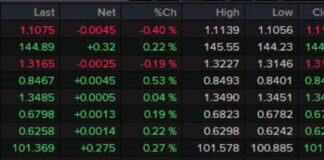European Central Bank Cuts Rates, Keeps Future Easing Options Open
The European Central Bank (ECB), as widely expected, cut its Deposit Rate by 25 bps to 3.50% at today’s monetary policy announcement. In lowering interest rates, the ECB described inflationary pressures as still elevated but moderating. Accordingly, the announcement included a mixture of both hawkish and dovish comments. The ECB said:
Domestic Inflation and Labor Cost Pressures:
The ECB acknowledged that domestic inflation remains high as wages are still rising at an elevated pace. However, the central bank also noted that labor cost pressures are moderating and profits are partially buffering the impact of higher wages on inflation. This cautious approach reflects the ECB’s stance on managing inflation while supporting economic growth.
Core CPI Inflation Projections:
In its updated economic projections, the ECB revised its core CPI inflation forecasts slightly higher. This adjustment was attributed to persistent services inflation, indicating that certain sectors are still experiencing price pressures. The ECB’s projections suggest a slower ebbing in underlying inflation pressures than previously anticipated, emphasizing the need for continued monitoring and assessment.
Policy Guidance and Outlook:
The ECB emphasized that it will continue to follow a data-dependent and meeting-by-meeting approach to determining the appropriate level and duration of restriction in its monetary policy stance. The central bank refrained from pre-committing to a specific rate path, emphasizing flexibility in responding to evolving economic conditions. This cautious stance underscores the ECB’s commitment to maintaining stability while remaining adaptive to changing circumstances.
Economic Projections and Growth Forecasts:
Despite lowering its GDP growth forecasts, the ECB’s projections indicate a relatively positive outlook for core CPI inflation. The central bank’s forecast for Eurozone growth in the coming years remains moderate, reflecting ongoing challenges in the economic environment. The ECB’s projections underscore the need for continued policy support to sustain growth momentum and address inflation dynamics.
ECB President Lagarde’s Comments:
ECB President Lagarde’s post-meeting remarks highlighted the importance of resilience in addressing domestic inflation challenges. Her comments suggested a proactive approach to managing inflationary pressures while supporting economic recovery. Lagarde’s focus on the short-term outlook and upcoming monetary policy meeting in October signals the ECB’s readiness to act decisively when necessary.
Eurozone Economic Growth and Challenges:
The Eurozone economy has experienced a period of stagnation followed by a gradual return to expansion in 2024. While growth has been modest, underlying indicators suggest a positive trajectory. Consumer spending trends, government stimulus, and export performance have contributed to economic activity, albeit at a subdued pace. The mixed sentiment surveys reflect ongoing uncertainties but also hint at potential improvements in the near term.
Consumer and Business Investment Outlook:
Real household income trends have remained favorable, supported by gradual employment growth and income gains. Consumer spending has shown resilience, despite challenges in the business investment landscape. Declining profit growth and capacity utilization present obstacles to a robust investment rebound. The contrasting outlook for consumers and businesses underscores the need for targeted policy measures to stimulate investment and bolster economic activity.
Inflation Dynamics and Wage Pressures:
Services inflation has remained elevated, indicating persistent price pressures in certain sectors. Wage growth trends have started to slow, but current levels remain above pre-pandemic averages. The lack of a significant increase in productivity poses challenges for managing inflation and supporting sustainable growth. The ECB’s focus on wage moderation and productivity improvements reflects the central bank’s commitment to addressing underlying inflation dynamics.
Risks and Policy Implications:
Given the Eurozone’s productivity and cost backdrop, risks are tilted toward slower subsiding of inflation pressures than anticipated. The ECB’s steady pace of rate cuts underscores the central bank’s cautious approach to managing inflation while supporting economic recovery. Continued monitoring of wage trends, productivity levels, and inflation dynamics will inform the ECB’s future policy decisions, emphasizing the need for flexibility and adaptability in responding to evolving economic conditions.
Conclusion:
The European Central Bank’s recent rate cut and policy guidance reflect a balanced approach to managing inflation and supporting economic growth. The central bank’s cautious stance, data-dependent approach, and focus on underlying inflation dynamics highlight the complexity of the current economic environment. As the Eurozone navigates challenges in growth, inflation, and productivity, the ECB’s commitment to stability and flexibility will be crucial in shaping the region’s economic trajectory in the coming months.

















